
The upper platform of the new Bison Viewing Deck at the Fort Worth Nature Center and Refuge is nestled alongside a post oak tree. Photo by Michael Smith.
April 6, 2023
If you want to go where the buffalo call home, just stop by the Fort Worth Nature Center and Refuge.
Bison have been roaming around the Cowtown venue for 50 years.
According to Friends of the Fort Worth Nature Center and Refuge, it’s the only publicly accessible bison herd in North Texas.
With the opening of a new Bison Viewing Deck in March, visitors to FWNCR have a new vantage point from which to see first-hand the national mammal of the U.S.
“It is remarkable to have a one-of-a-kind experience for visitors to view the herd and other wildlife," said Haily Summerford, executive director of the Friends of the Fort Worth Nature Center & Refuge. "We are extremely grateful to the Ryan Foundation, H-E-B, and Anchor Construction for making this project possible. Our hope is the deck experience will inspire future generations to preserve and protect the Nature Center and pass that passion onto others.”
AMERICAN ICON
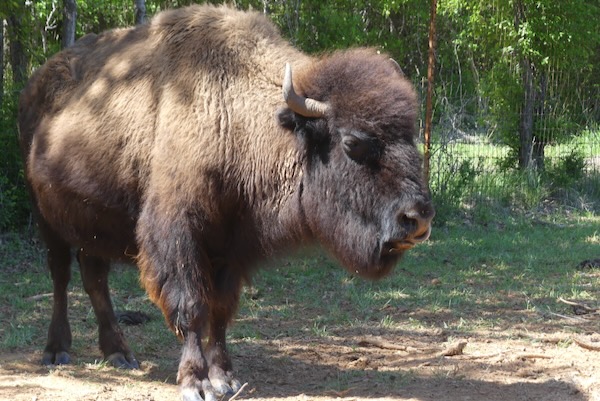 A bison from the Fort Worth Nature Center shows off the distinctive profile of the national mammal of the U.S. Photo by Michael Smith.
A bison from the Fort Worth Nature Center shows off the distinctive profile of the national mammal of the U.S. Photo by Michael Smith.
On a recent visit to the Fort Worth Nature Center, I spotted the familiar profiles grazing in a pasture. We here in DFW are lucky to have this opportunity.
In the 1800s, bison were culled down from 60 million to less than 1,000 animals. Thanks to efforts in the mid-20th century, the Plains native has recovered from near-extinction to around 20,000 in conservation today.
They’re an icon of America, but we still don’t call them by their right name. Bison have popularly been called “buffalo” since early European explorers first saw them. True buffalo are found only in Africa and Asia.
Most of us instantly recognize them — enormous beasts with dark brown woolly coats in winter and lighter-weight, lighter-brown coats in summer. Both sexes have a hump around the shoulders and short horns curving up from the sides of their head.
The large hump at the bison's shoulders is from large, strong muscles that allow the bison to push snow (or anything else) out of the way and plow through drifts to get to grass in winter. Those big muscles are attached to tall extensions of the backbone known as vertebral processes.
Watching the gargantuan grazers, I surmised one could fling me out of her way with a flick of her head.
The hump makes it seem like the head is held low, and the back half of the body seems a little smaller than the front. But otherwise nothing is small about these creatures — the largest land mammal in North America.
Bison bulls may stand six feet at the shoulder. Average weights vary, but it is not unusual for a bison cow to weigh nearly 1,000 pounds and for a bison bull to weigh over 1,500 pounds.
FORT WORTH HERD
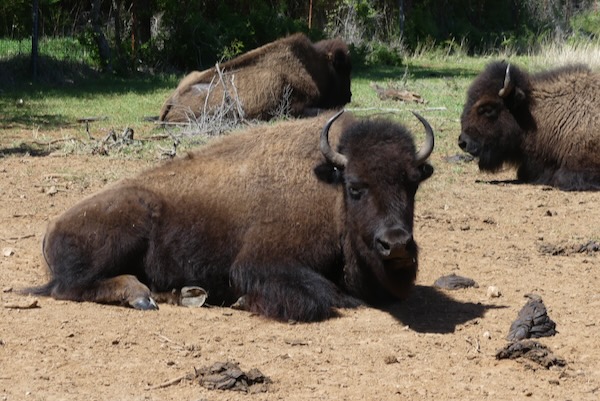 A bison relaxes on a warm spring day in March at the Fort Worth Nature Center. Photo by Michael Smith.
A bison relaxes on a warm spring day in March at the Fort Worth Nature Center. Photo by Michael Smith.
The Fort Worth Nature Center and Refuge maintains a herd of about 12 to 15 of these animals, living within fenced pastures and often visible to the public. The bison are actually owned by the Friends of Fort Worth Nature Center and Refuge.
The original three bison were a donation from the Wichita Mountains Wildlife Refuge. The Refuge’s first bison calf, a heifer, was born on May 21, 1974. The herd currently consists of one adult bull, 12 cows, and five calves that were born this year.
The herd is rotated through five pastures to ensure the land remains a healthy ecosystem for the bison and other wildlife. So sometimes you might not see them on a visit.
To improve bison-watching at the Nature Center, a viewing deck was recently built using $450,000 in grant money.
The deck, built by Indiana-based Anchor Construction, starts with a ramp to a 10-foot-square deck standing four feet above the ground. From there, the ramp continues to a height of 11.5 feet. At that level, a 30-by-20-foot deck straddles two pastures and lets visitors stand within the tree canopy to watch the herd as they graze or loll in the shade.
BISON ETIQUETTE
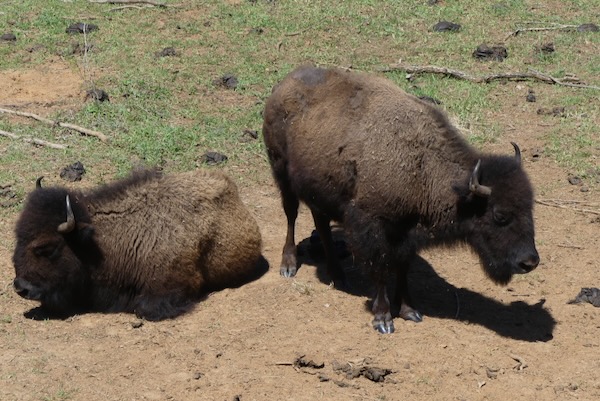 A view of the bison from the upper deck. Photo by Michael Smith.
A view of the bison from the upper deck. Photo by Michael Smith.
As I watched the bison at FWNCR, they seemed very placid, hanging around quietly while visitors looked at them. But bison are wild animals, not like cattle on a farm.
Bison personalities may vary, and some may seem docile and shy. However, there are many examples of rangers or ranchers being injured or killed with little warning.
There has never been an injury to the public or to staff during the 50 years since the first bison arrived at FWNCR on Nov. 9, 1973.
Bison can be very fast, and a herd may stampede at speeds over 35 miles per hour. Such stampedes may be triggered by fairly insignificant events.
They don’t like being held or guided through enclosures.
Bison are described as becoming more intolerant as they get older. When the herd is checked by a veterinarian, the Nature Center staff have a very full day as bison are held in a pen and moved into a narrow chute.
“Like every species of animal, you have to know them,” said Rob Denkhaus, the manager of FWNCR. “If you know them, understand their biology, their behavior and triggers, they’re easy to work with.”
It’s important to “limit the stressors on them,” he said.
They have adequate pasture land to graze, and the winter pasture is away from the public, which also helps with stress.
HISTORY
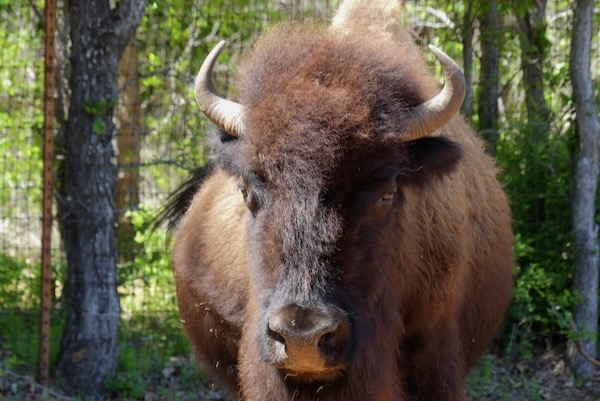
Both male and female bison have horns. Photo by Michael Smith.
Bison have been part of the wildlife of North America for more than 400,000 years, beginning during the Pleistocene Epoch or “Ice Age.” The earliest bison may have come from Siberia to North America over a bridge of land connecting Siberia to what is now Alaska.
Humans hunted the Eurasian bison nearly to extinction. The numbers of Old World bison or “wisent” dwindled until, after World War I, just nine of them remained.
In North America, Native Americans living in the Plains depended heavily on bison but apparently were not a threat to their numbers.
In the later 1800s, the U.S. government subsidized hide hunters as a way of forcing Native Americans onto reservations. Eliminating bison deprived the Native Americans of food and many of the materials used in their daily life. An army colonel at the time told a reluctant hunter
“Kill every buffalo you can! Every buffalo dead is an Indian gone."
Hunting and slaughter during that time brought the bison nearly to extinction.
What would it have been like to see them in the 19th century when they numbered in the millions?
In 1842, Philip St. George Cooke found himself in the middle of a stampede in which he was nearly trampled (and his horse was gored to death). He wrote:
“Suddenly a cloud of dust rose over [the crest of the hill], and I heard a rushing noise as of a mighty whirlwind, or the charging tramp of ten thousand horse [sic]. I had not time to divine its cause, when a herd of buffalo arose over the summit, and a dense mass, thousand upon thousand, gallopped [sic] with headlong speed, directly upon the spot where I stood. There seemed no possible escape for me; the vast inundations extended far to the right and left, backed by huge squadrons, who pressed forward in their panic, shoulder to shoulder; and the black surface of the mass, heaved and subsided like the waves of a raging ocean.”
Originally, Plains bison ranged all the way from New York to northern California, though absent from much of the desert Southwest and from many coastal regions. Now their descendants may live on private ranches, nature centers such as FWNCR, or public lands managed by the Department of Interior. That agency manages 17 bison herds — or approximately 10,000 bison—in 12 states, including Alaska.
In North America, there are two “kinds” or subspecies of bison: the wood bison that originally lived in Canada and Alaska, and the Plains bison that was found from southern Canada to northern Mexico. The two bison are similar, with the wood bison being somewhat larger, with a little longer neck and a few other differences in form and “shagginess.”
BISON LIFE
Bison are primarily grazers on grasses and sedges on the ground, but will browse on shrubs, depending on the habitat in which they live. In most parts of their range, bison prefer open grassland and meadow. Grassland ecosystems thrive on their grazing, trampling, wallowing, defecating and urinating. For example, some grass species send up more new growth after they are grazed, and bison urine contributes nitrogen, which fertilizes the soil.
Bison will use rubbing posts and bulls may thrash and horn trees and shrubs during rut. Such activities help suppress the growth of trees and shrubs, which can take over a prairie if not controlled. Compared to cattle, bison are less likely to re-graze an area during a single growing season, wander more, eat drier and rougher plants, and are less likely to trample and churn up wetlands.
Like cattle and other ruminants, bison have four stomachs, so that food is transferred from one to the next. This allows them to digest the cellulose found in grasses and other plants which is very hard to break down.
HERD MANAGEMENT
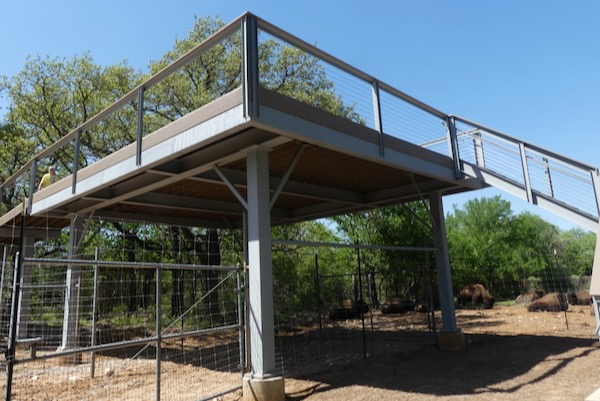 Seen from below, the upper platform looks out onto bison pastures. Photo by Michael Smith.
Seen from below, the upper platform looks out onto bison pastures. Photo by Michael Smith.
The herd at FWNCR is composed of Plains bison with no evidence of cattle genes. There have been attempts to hybridize bison with cattle to make a hardier animal that is easier to work with. Those attempts did not work out well. As Denkhaus puts it, “within the limits of current genetic technology, our bison herd is pure.”
The Nature Center periodically sells bison, within either the National Bison Association or the Texas Bison Association. Calves are born from time to time, but the herd’s numbers must be kept low to be a good fit for the available pastures. Buyers may maintain herds for multiple reasons, such as maintaining genetically pure stock for conservation of the species, exhibiting bison to the public, or as an ecological herd. An “ecological herd” as Denkhaus described it, “is used in land management to maintain healthy prairies.”
Some bison may be sold to ranches producing meat or hides. Such ranches extend the long relationship between humans and bison, back to the times when indigenous Americans depended on hunting them.
But some of them are not sold.
“Bison herds are matriarchal, and so bison cows are allowed to die here,” said Denkhaus. “Their personality sets the tone for the herd.”
Staff do use individual names for the bison, like Hernanda, Yosie or Maverick.
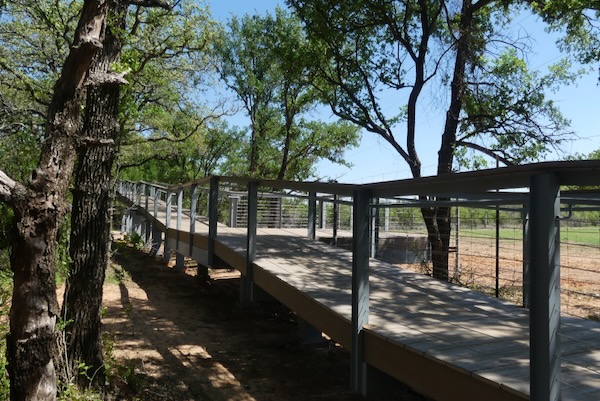
The ramp to the Bison Deck is gently sloped and is wheelchair and walker accessible. Photo by Michael Smith.
As I stood at ground level taking photographs, I had no idea whether I was standing near Yosie or if that was Hernanda taking it easy in the sunshine. Everyone was tail-swishing, which is said to be an indicator of a bison in an easygoing mood.
On the other hand, all photos were taken through a fence and some images were pulled up close by the camera lens. It is important to respect the power and unpredictability of these animals.
If there is no fence, the National Park Service warns people to stay at least 75 feet, or about the length of five cars, away from bison, especially around places where the animals may be more stressed (areas with greater human activity).
ADDITIONAL SOURCE: Reynolds, H.W, Gates, C.C. & R.D. Glaholt. 2003. Bison. In Feldhamer, Thompson & Chapman (Eds.) Wild Mammals of North America: Biology, Management, and Conservation, 2nd Edition. Baltimore: The Johns Hopkins University Press.
RELATED ARTICLES
Fort Worth Nature Center expanding boardwalk
New land acquired by Fort Worth Nature Center will serve as buffer
Fort Worth Nature Center offers window into region’s wild past
Stay up to date on everything green in North Texas, including the latest news and events! Sign up for the weekly Green Source DFW Newsletter! Follow us on Facebook and Twitter. Also check out our new podcast The Texas Green Report, available on your favorite podcast app.









